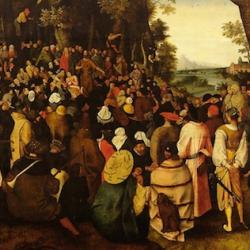What is the “Federal Vision” or “Auburn Avenue” dispute about? Partly, it’s about theology. I believe the core dispute has to do with nature and importance of what Reformed theologians call the “visible church,” the universal body of believers organized in empirical local communities. A central contention of the “Federal Vision” position is that Reformed theology, with its strong doctrine of God’s sovereignty and absolute election, has sometimes neglected the significance of the visible church, its ministries, and its sacraments. For certain tributaries in the stream of Reformed theology, the only thing that matters is that my name is on the list of those elected by God’s absolute decree, not whether I’m on any membership list of a church. What matters is that I’ve been baptized by the Holy Spirit, not whether or not I’ve been baptized in water. What matters is that I’m joined mystically to Christ, not that I feed on bread and wine at His table.
This is not, as I see it, the original vision of Calvin, who combined a strong emphasis on God’s absolute decree with a high doctrine of the church. The same Calvin who taught double predestination cited, at the beginning of Book 4 of the Institutes , the patristic axiom that we cannot have God as our Father unless we have the church as our mother. Calvin spoke of a “general election” of the visible church, as well as a “special election” of the invisible. In the Geneva Catechism of 1545, Calvin indicates that baptism is a figure, but a figure that, for believers, has the “reality . . . annexed to it; for God does not disappoint us when he promises us his gifts. Accordingly, it is certain that both pardon of sins and newness of life are offered to us in baptism, and received by us.” Calvin rejected transubstantiation, but he remained in awe of the Eucharistic mystery and insisted that believers genuinely feed on Jesus Christ at the Lord’s table.
For various reasons, this high ecclesiology was eclipsed in conservative Reformed theology, particularly in the United States, so that the great Princetonian B. B. Warfield could say that the Reformation was the triumph of Augustinian soteriology over Augustinian ecclesiology. “Federal Vision” theology claims that Calvin is Augustinian on both points, and represents, without simply repeating Calvin’s formulations, an effort to recover the high ecclesiology of the original Reformed tradition.
Broadly speaking, Christian theologians spent the twentieth century with ecclesiology, the ecumenical movement and Vatican II being the most visible results. “Federal Vision” theology is an effort to drag conservative Reformed theology, kicking and screaming, into the twentieth century. (That’s not a typo or mistake; I know it’s the twenty-first century.)
Many opponents would, of course, dispute this characterization of the dispute. Determining precisely what issues are controverted is here, as always, a central part of the controversy, and for many “Federal Vision” theology is not only a radical, heretical re-casting of Reformed theology but an abandonment of the gospel. We have been accused of teaching “another gospel,” while, strangely, simultaneously been accused of being Lutherans. That the rhetoric has become this heated in some quarters is remarkable, and this visceral reaction invites some reflection.
After the Reformation, Reformed churches found themselves striving not only with Catholics but with Lutherans, and as a result both Reformed and Lutheran dogmatics developed along the lines of a one-sided, though historically understandable, via negativa . Reformed theology had its own resources on which to draw, but at many points, and particularly on issues of ecclesiology and sacraments, defined itself as not-Lutheran and not-Catholic. Lutherans did the same. My church history professor at seminary said that Lutheran dogmatics texts had a threefold structure: The Catholic Error, the Reformed Error, and the Lutheran Truth. Reformed theologians followed (and some still follow) a similar method. Reformed theologians and churches, as a result, formed their identity as Reformed by distinguishing their views and practices from Lutherans and Catholics. In the wake of the fundamentalist controversy, Presbyterians added another element to this theological method – we are not-liberals. The badge of inclusion in the Reformed world was not teaching any form of baptismal regeneration.
“Federal Vision” theology messes with these boundaries. It attempts to follow the lead of Scripture, even when that seems to conflict with Confessional formulae and seems closer to Luther than Reformed orthodoxy. It develops a baptismal theology that is not starkly at odds with Luther, appreciates de Lubac on the doctrine of the church and Alexander Schmemann on the Eucharist, finds Barth and Lindbeck intriguing and helpful at a number of points, and is stimulated by Anglican New Testament scholar N. T. Wright. As a result, “Federal Vision” theology challenges conservative Reformed culture as much or more than it does Reformed theology, for it questions the performances and boundaries that once defined this culture. Though the specifics of the debate can appear to be so much gnat-straining (particularly to those few outside the Reformed world who pay attention), the debate touches a nerve and provokes profound reactions because it’s not just a theological debate but an identity crisis. The Federal Vision challenges some of the identifying symbols, the boundary-markers of Reformed communal identity, and that kind of challenge cannot help but provoke a heated response.
From this angle, the future shape of American Presbyterian will be significantly shaped by the outcome of this debate. It appears to me that one of the issues facing the OPC and the PCA is whether we will isolate ourselves in an ever-more enclosed sectarian form of Christianity or whether we will more and more see ourselves as a distinctive stream of the catholic church.











